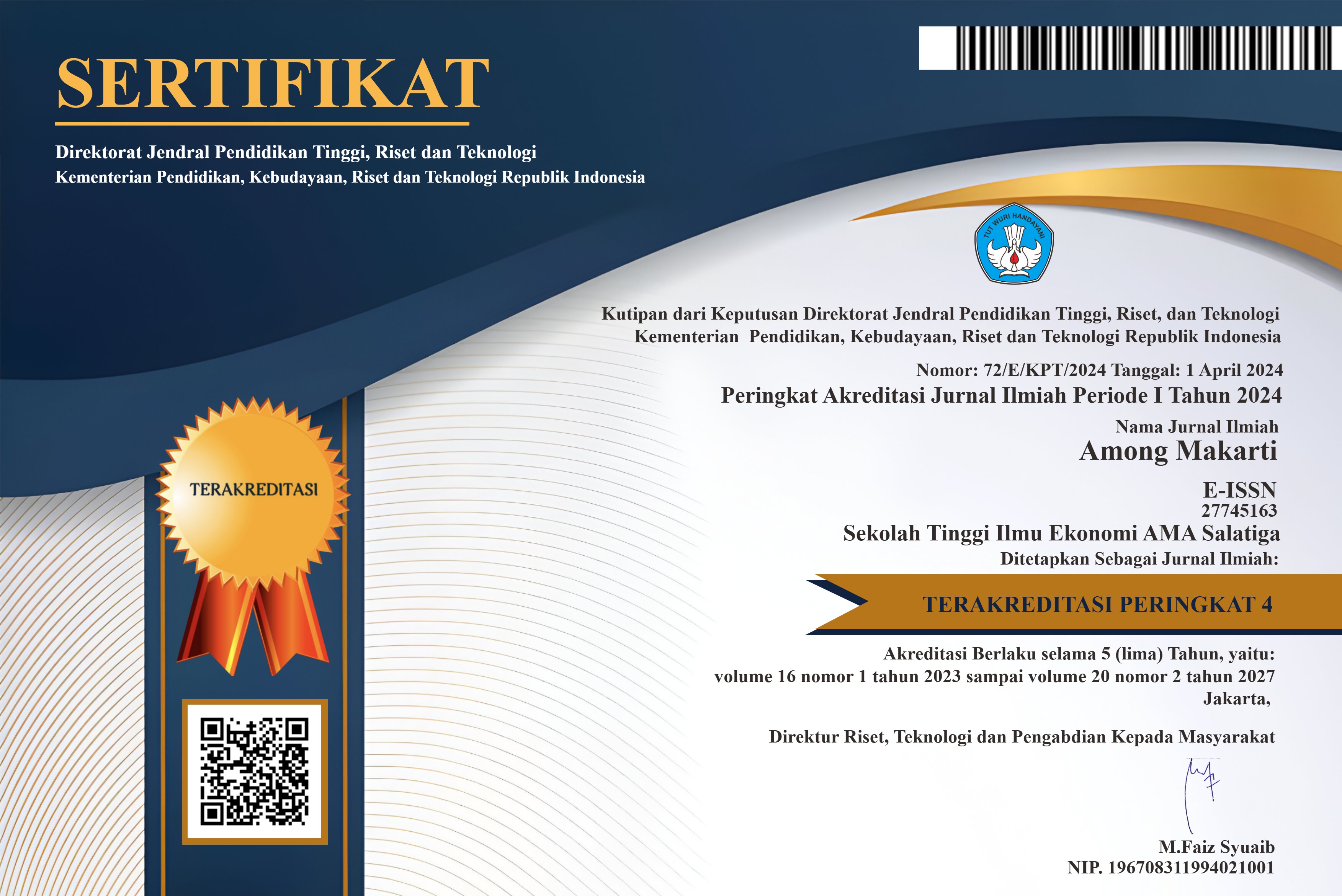PENGARUH KEPEMIMPINAN YANG MELAYANI TERHADAP PERILAKU INOVASI KERJA PEGAWAI PADA SEKTOR PUBLIK DENGAN ALIRAN DI TEMPAT KERJA SEBAGAI VARIABEL INTERVENING
Abstrak
Kata Kunci
Teks Lengkap:
PDFReferensi
BKN. (2022). Statistik ASN Desember 2021. Badan Kepegawaian Negara.
Cai, W., Lysova, E. I., Khapova, S. N., & Bossink, B. A. G. (2018). The effects of servant leadership, meaningful work and job autonomy on inovative work behavior in Chinese high-tech firms: A moderated mediation model. Frontiers in Psychology, 9. https://doi.org/10.3389/fpsyg.2018.01767
Csikszentmihalyi, M. (2009). Flow: The psychology of optimal experience (Nachdr (ed.)). Harper and Row.
de Jong, J., & den Hartog, D. (2010). Measuring inovative work behaviour. Creativity and Inovation Management, 19(1), 23–36. https://doi.org/10.1111/j.1467-8691.2010.00547.x
Dierendonck, D. van. (2010). Servant leadership: A review and synthesis. Journal of Management, 37(4), 1228–1261. https://doi.org/10.1177/0149206310380462
Eva, N., Robin, M., Sendjaya, S., van Dierendonck, D., & Liden, R. C. (2018). Servant Leadership: A systematic review and call for future research. Leadership Quarterly, 30(1), 111–132. https://doi.org/10.1016/j.leaqua.2018.07.004
Fredrickson, B. L. (2001). The role of positive emotions in positive psychology. American Psychologist, 56(3), 218–226. https://doi.org/10.1037/0003-066X.56.3.218
Gabris, G. T., Golembiewski, R. T., & Ihrke, D. M. (2000). Leadership credibility, board relations, and administrative innovation at the local government level. Journal of Public Administration Research and Theory, 11(1), 89–108. https://doi.org/10.1093/oxfordjournals.jpart.a003496
Hair, J. F., Hult, G. T. M., Ringle, C. M., & Sarstedt, M. (2017). A primer on partial least squares structural equation modeling (PLS-SEM). In L. Fargotstein (Ed.), Sage (Second edi). Sage Publisher.
Iqbal, A., Latif, K. F., & Ahmad, M. S. (2020). Servant leadership and employee innovative behaviour: exploring psychological pathways. Leadership and Organization Development Journal, 41(6), 813–827. https://doi.org/10.1108/LODJ-11-2019-0474
Janssen, O. (2000). Job demands, perceptions of effort-reward fairness nd inovative work behavior. Journal of Occupational and Organizational Psychology, 73, 287–302.
Keller, J., & Bless, H. (2008). Flow and regulatory compatibility: An experimental approach to the flow model of intrinsic motivation. Personality and Social Psychology Bulletin, 34(2), 196–209. https://doi.org/10.1177/0146167207310026
Khan, M. M., Mubarik, M. S., Ahmed, S. S., Islam, T., & Khan, E. (2021). Innovation with flow at work: exploring the role of servant leadership in affecting innovative work behavior through flow at work. Leadership and Organization Development Journal, 42(8), 1267–1281. https://doi.org/10.1108/LODJ-05-2021-0236
Liden, R. C., Wayne, S. J., Liao, C., & Meuser, J. D. (2014). Servant leadership and serving culture: Influence on individual and unit performance. Academy of Management Journal, 57(5), 1434–1452. https://doi.org/10.5465/amj.2013.0034
Liden, R. C., Wayne, S. J., Meuser, J. D., Hu, J., Wu, J., & Liao, C. (2015). Servant leadership: Validation of a short form of the SL-28. Leadership Quarterly, 26(2), 254–269. https://doi.org/10.1016/j.leaqua.2014.12.002
Li, F., Liu, B., Lin, W., Wei, X., & Xu, Z. (2021). How and when servant leadership promotes service innovation: A moderated mediation model. Tourism Management, 86(July 2020), 104358. https://doi.org/10.1016/j.tourman.2021.104358
Liu, D., Jiang, K., Shalley, C. E., Keem, S., & Zhou, J. (2016). Motivational mechanisms of employee creativity: A meta-analytic examination and theoretical extension of the creativity literature. Organizational Behavior and Human Decision Processes, 137, 236–263. https://doi.org/10.1016/j.obhdp.2016.08.001
Madrid-Guijarro, A., Garcia, D., & Van Auken, H. (2009). Barriers to inovation among spanish manufacturing SMEs. Journal of Small Business Management, 47(4), 465–488. https://doi.org/10.1111/j.1540-627X.2009.00279.x
Mansury, M. A., & Love, J. H. (2008). Inovation, productivity and growth in US business services: A firm-level analysis. Technovation, 28(1–2), 52–62. https://doi.org/10.1016/j.technovation.2007.06.002
Mulgan, G., & Albury, D. (2013). Inovation in the public sector. Inovation Policy Challenges. https://doi.org/10.4324/9780203084243-11
Ruiz-Palomino, P., Hernández-Perlines, F., Jiménez-Estévez, P., & Gutiérrez-Broncano, S. (2019). CEO servant leadership and firm innovativeness in hotels: A multiple mediation model of encouragement of participation and employees’ voice. International Journal of Contemporary Hospitality Management, 31(4), 1647–1665. https://doi.org/10.1108/IJCHM-01-2018-0023
Schiepe, A., & Engeser, S. (2017). Flow at work: Measurement and implication (C. Fullagar & A. D. Fave (eds.); First edit). Routledge.
Sekaran, U., & Bougie, R. (2016). Research methods for business: A skill building approacg. John Wiley & Sons Ltd.
Shin, S. J., & Zhou, J. (2003). Transformational leadership, conservation, and creativity: Evidence from Korea. Academy of Management Journal, 46(6), 703–714. https://doi.org/10.5465/30040662
Urbancova, H. (2013). Competitive Advantage Achievement through Inovation and Knowledge. Journal of Competitiveness, 5(1), 82–96. https://doi.org/10.7441/joc.2013.01.06
Vries, H. de, Bekkers, V., & Tummers, L. (2016). Innovation in the public sector: A systematic review and future research agenda. Public Administration, 94(1), 146–166. https://doi.org/10.1111/padm.12209
Zubair, A., & Kamal, A. (2015). Work related flow, psychological capital, and creativity among employees of software houses. Psychological Studies, 60(3), 321–331. https://doi.org/10.1007/s12646-015-0330-x
DOI: http://dx.doi.org/10.52353/ama.v15i2.319
Refbacks
- Saat ini tidak ada refbacks.
Copyright (c) 2022 Riza Dwi Agni, Era Miftakhul Jannah

This work is licensed under a Creative Commons Attribution-ShareAlike 4.0 International License.
AMONG MAKARTI : JURNAL EKONOMI DAN BISNIS
SEKOLAH TINGGI ILMU EKONOMI AMA SALATIGA
 Jl. Diponegoro No.39, Salatiga, Kec. Sidorejo, Kota Salatiga, Jawa Tengah
Jl. Diponegoro No.39, Salatiga, Kec. Sidorejo, Kota Salatiga, Jawa Tengah
TERINDEKS :

This work is licensed under a Creative Commons Attribution-ShareAlike 4.0 International License.



























